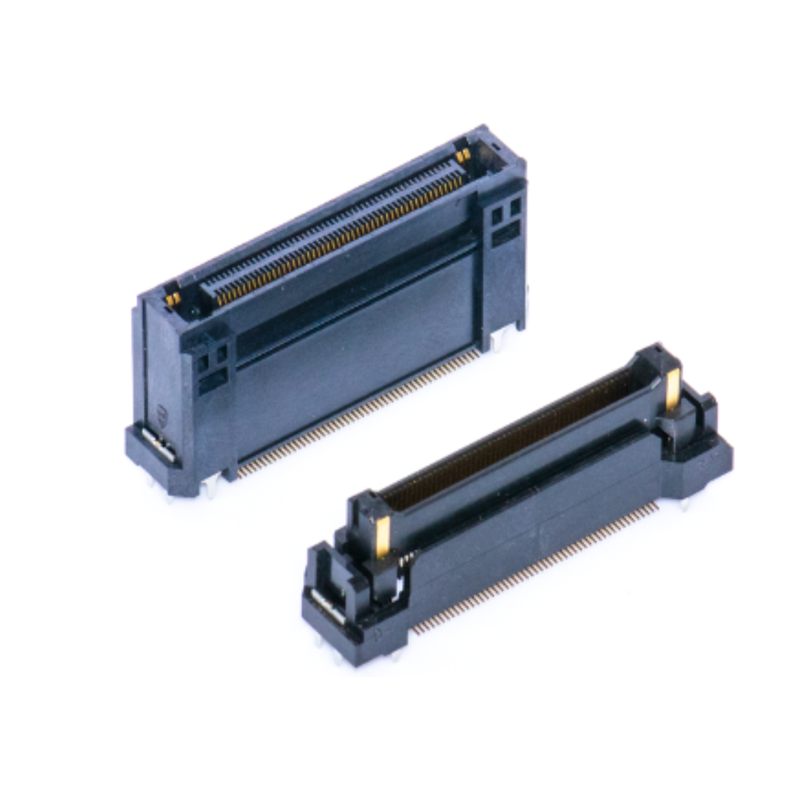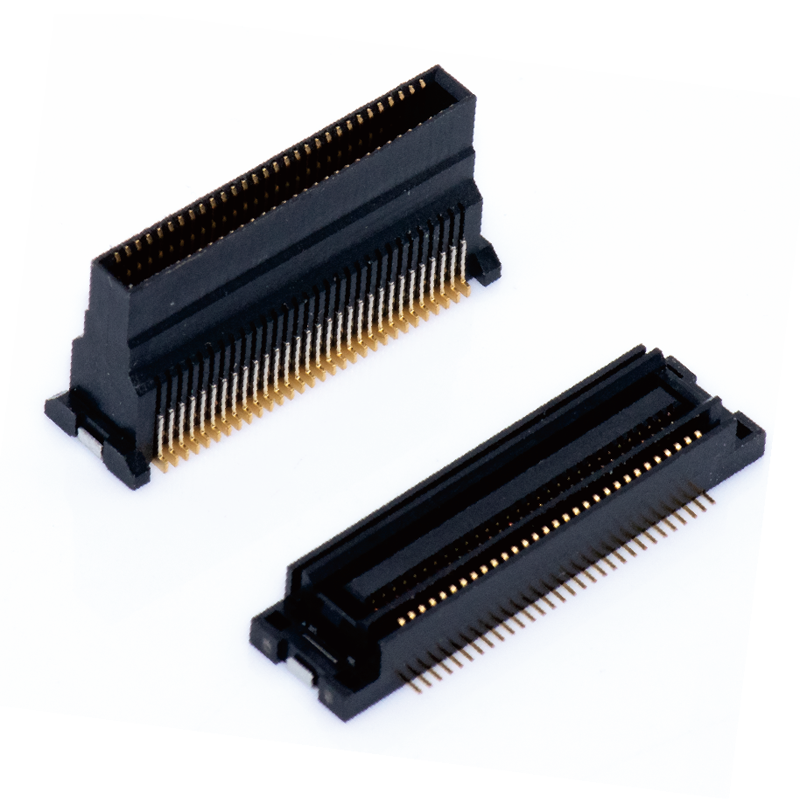What is a floating board-to-board connector
As terminal equipment develops towards high performance, the demand for electronic control of important components is also rapidly increasing, and the reliability requirements for connectors are also further improved.
Among them, board-to-board connectors are divided into two types: "rigid" and "floating". The connection between "rigid" connectors is fixed. In the case of rigid connectors without floating functions, if misalignment occurs during the installation process, this will cause damage when the connectors are mated; even if the mating is successful, the Vibration, impact or heating generated when stress is applied to the welded part may cause the solder to crack and cause conduction failure.
Faced with these connection problems, floating board-to-board connectors emerged as the times require.
"Floating Connector" is a board-to-board connector that has the function of absorbing and correcting errors (tolerances) in the ±X and ±Y directions when mounted on a substrate.
Edit Search Image What are the advantages of floating board-to-board connectors?
1. Eliminate misalignment and facilitate PCB assembly of connectors
When the connector is assembling various components on the PCB, all installation positions must be accurate. The floating board-to-board connector can eliminate the misalignment of the substrate during PCB assembly and the positional offset during mating, making it It is more compatible with PCB automated assembly process. While traditional board-to-board connectors may require manual assembly, floating connectors enable efficient automated PCB assembly.
"The special advantageous performance of floating board-to-board connectors and the fully automated assembly can help companies realize smart manufacturing and unmanned factories. Therefore, many original design solutions will be converted into floating board-to-board connectors." Xiamen Chen Bingshui, general manager of Guanghong Industry and Trade Co., Ltd. said.
Edit and search pictures 2. Flexible design, a single PCB can accommodate multiple board-to-board connectors
In practical applications, PCB connections sometimes involve multiple connection points. If traditional board-to-board connectors are used, accurate alignment is very difficult. However, floating board-to-board connectors have the performance advantage of easily eliminating tolerances. A single PCB can easily accommodate multiple board-to-board connectors, improving layout and wiring freedom and increasing design flexibility.
Edit and search pictures 3. Reduce stress and achieve reliable matching
On traditional board-to-board connectors, external shock and vibration can easily cause the connector to dislocate and generate stress. The accumulated stress may be transmitted to the PCB and other connectors and solder joints, causing the host to malfunction. The floating board-to-board connector is equipped with a spring mechanism internally to absorb the misalignment of the substrate during installation and positional deviation during mating. The stress generated during this period will be borne by the spring, which can effectively reduce the stress caused by misalignment. , prevent solder joints from breaking and achieve reliable mating.
Edit image search can replace traditional board-to-board connectors in many fields
Based on the above characteristics, floating board-to-board connectors have more obvious advantages than traditional board-to-board connectors, which are specifically reflected in various applications in automotive, industrial control, consumer electronics and other fields.
1. Industrial applications: PLC, CNC, industrial PC, sensor units and controllers, etc.
"The working environment of industrial equipment is high-vibration, and floating connectors are very suitable for use in industrial equipment." said Chen Bingshui of Guanghong Industry and Trade.
In other words, the vibration and pressure resistance of the floating board-to-board connector can adjust and absorb deformation or wear due to continuous vibration. Therefore, industrial equipment has become one of the main application areas of floating board-to-board connectors.
2. Automotive applications: wireless modules, engine ECUs, vehicle navigation systems, audio and video systems, radar systems and battery management systems, etc.
The automotive market is currently focusing on researching ADAS and driverless systems, which requires the installation of more high-performance vehicle ECUs to ensure the safety performance of the vehicle. More information processing is required inside this high-performance ECU. Since multiple PCB boards are used inside, the demand for board-to-board connectors also increases.
The vibration frequency of the car during driving is high. The soft spring structure of the floating board-to-board connector can reduce the vibration generated by the car during driving, absorb stress and prevent cracking, ensuring the high reliability of the product.
In addition, Xie Yingji, marketing manager of Gekang Electronic Technology (Shenzhen) Co., Ltd., also said that the number of connectors used on PCB boards of new energy models (car navigation) will be increasing. "If we still use traditional connectors, the specification requirements are particularly strict. After the displacement function of the floating board-to-board connector eliminates tolerances, the specification requirements can be relaxed while ensuring the stability of its signal transmission. .”
3. Consumer electronics: LED display
Since the LED display is made up of small displays, the traditional connection method cannot be completed in one step and is difficult to meet its assembly needs. The floating board-to-board connector can easily align and adjust the LED display splicing process. gap to ensure that the entire screen can be fully spliced.
According to Xie Yingji of Gekang Electronics, a 130-inch LED display will use about 100 sets of floating board-to-board connectors. The characteristics of floating board-to-board connectors make them widely used in the LED display industry.
Future development trend: miniaturization, multi-functional integration
With the gradual advancement of the trend of product miniaturization, this has also promoted the demand for small size connectors. At the same time, most existing connectors cannot achieve high current and high speed at the same time, and many different connectors are needed to transmit signals and current. Floating board-to-board connectors are slowly integrating these capabilities.
Xie Yingji of Gekang Electronics said that the current floating board-to-board connector is mainly for transmitting signals. In the future, it will have the function of signal and large current transmission. After integration, it can effectively save the space of the entire PCB. In future products With the trend of miniaturization, one floating board-to-board connector can serve multiple functions.
Miniaturization and integration are both directions and challenges.
Han Qi, design director of Amphenol Aurora Technology (Huizhou) Co., Ltd., said that because of its special floating structure, floating board-to-board connectors have certain limitations in miniaturization, so they are moving towards smaller spacing (such as: 0.3mm, 0.4mm), lower height is a major difficulty.
Guanghong Industry and Trade Chen Bingshui added that on the premise of multi-functional integration and high reliability, the floating board-to-board connector will be larger than the ordinary board-to-board connector, but this also means that it will be used in many applications. There are restrictions in application scenarios. Therefore, the next challenge for floating board-to-board connectors is to miniaturize them to adapt to more scenarios while being floatable and highly reliable.
How to ensure product quality?
While floating board-to-board connectors are further expanding their market applications, they still need to continue to improve their product quality. We pay attention to everything from early mold design, raw material selection, simulation to later testing to ensure that product accuracy, structural performance and electrical performance meet customer and industry requirements.
Xie Yingji of Gekang Electronics summarized the following points: The early structural design of floating board-to-board connectors should be as far as possible to achieve automated production during manufacturing. Secondly, in terms of material selection, in order to ensure the elastic function and yield strength of the connector terminal, high-quality phosphor copper is selected to ensure that the connector reaches the best state during the floating process. At the same time, in order to take into account both reflow soldering and wave soldering methods, Gekan Electronics chose LCP materials when selecting materials. Thicker gold plating is used on the contact end of the product to ensure the reliability of product contact.
At the same time, product fineness also depends on the material and mold.
"The accuracy of molds and materials will be directly reflected on the connector parts," Aurora Hanqi said. For example, in the selection of copper materials, impurities in copper materials will lead to unstable product performance and have a great impact on the accuracy of parts. Impact.
Han Qi believes that this is a running-in process. From the supplier of the mold to the selection of mold materials, to the structural design requirements of downstream manufacturers, every stage requires running-in.
From simulation design to material selection, Guanghong Industry and Trade will choose major domestic and foreign manufacturers to ensure the manufacturing quality of the products, and then import the finished products into third-party testing institutions to test the performance and reliability of the products.
"Our company has always cooperated with major international companies such as ABB, Panasonic, Philips, and GE. We have very high standards and requirements in terms of early design, production and operation control, etc. When we inspect the factory every year, we All can meet the standards." Chen Bingshui, director of Guanghong Industry and Trade, added.


Facing the blue ocean market, how should companies lay out their plans?
It is understood that the more representative companies in the field of floating board-to-board connectors are Lisu, Hirose, KEL, JAE, etc. They have been involved in the floating connector sector early, have complete specifications and master the core technology. Therefore, in the past, floating connectors mostly relied on imports.
Now more and more domestic and foreign companies are targeting this field for layout. It is worth mentioning that some local Chinese companies have slowly mastered core technologies through research and development, have relatively mature processes and can achieve mass production.


